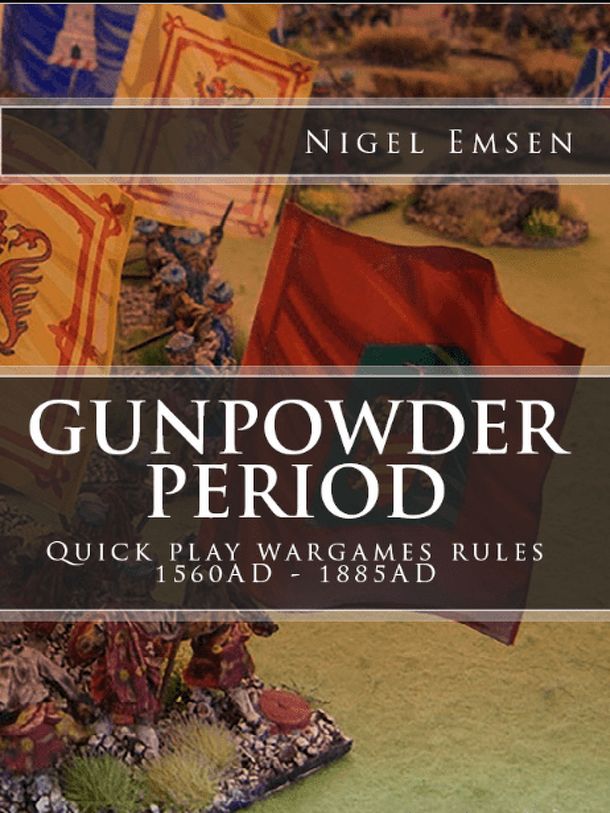Gunpowder Period társasjáték
társasjáték, 2016
A Gunpowder Period egy remek társasjáték, 2 játékos részére. A játékmenet erősen épít a szimuláció mechanizmusra.
Angol:
Gunpowder Period: Quick play wargames rules for 1560AD - 1885AD The design philosophy of the Gunpowder rules provides a simple approach that can be used to play wargame battles...
Angol leírás
Gunpowder Period: Quick play wargames rules for 1560AD - 1885AD
The design philosophy of the Gunpowder rules provides a simple approach that can be used to play wargame battles at brigade or higher command levels, irrespective of the figure scale (6mm, 10mm, 15mm, 25mm and even 1/32 scale) with your own current models and common basing formats currently in use. There are many very good rule sets aimed at a specific period in the hobby which provide a detailed simulation of warfare in that period. These rules have been designed to provide the player with challenges based around the manoeuvre and the management of their units in a quick play format while still maintaining a feel for the period. An army within the game is typically 20 units as side broken down into distinct command groups. A unit is a single base. The rules use 100mm equal to one range/movement unit and a unit has a footprint of 120mm wide by 30mm – 80mm depth depending the formation and unit type. The rules have been designed to provide capability options at the unit level, while still presenting the dilemma to the player that they cannot complete all the traditional phases (shooting, moving, charging and reforming) during a turn with that specific unit. These rules instead of using a traditional system of very distinct detailed weapon factors and micro-managed movement rates, they provide a game framework that looks at the different unit’s capabilities compared to that of the unit’s opponents for the period. This enables the player to apply their own knowledge of the historic period to represent the way a specific unit should perform with in the game. The rules also do not use the IGUGO turn approach, but instead each action, (reform, charge, move and shoot) can be done in any sequence and up to twice in a turn. This keeps both players engaged throughout a turn sequence. A unit has a limit of two actions in any turn. The players take it in turns to complete these actions by unit. Also, the rules do not focus on detailed weapon factors and actions within a specific game turn time frame, but use the approach: “Was the specific unit any better or worse on the battlefield for the period?” For example, all units could have used volley fire, but was this specific unit any better/worse at than anyone else? The rules manage this through a unit being given a selection of capabilities. The rules make a difference between the plug and socket bayonets. This is handled by the unit completing a distinct action to counting them fitted. This means when a plug bayonet is fitted, the unit cannot shoot. This formation is called “Foot cavalry defence”. This also covers the use the of foot squares as an anti-cavalry defence. The rules have to make a comprise and when a unit is claiming “foot cavalry defence” they also count as a deep formation even when a unit is in line with bayonets fitted. All units break at the same point, regardless of if the unit is veteran, regular or militia. What is managed within the rule set is how quickly or slowly a unit reaches that point of failure. Generals are used for command and control only. Units must be organised into command groups. An army for the game is organised into a number of these command groups with an overall army commander. Generals can only command units within their group and the army commander can command any units across all command groups. Typically, a command group is a brigade, division or corps depending on the scale you have adopted for the army. Games can be played over a two-hour time limit with a scoring system based around the number of units that one side has managed to kill. The rules reward aggressive play; thus, hopefully avoiding a static game. For a specific historical battle use the objectives of the actual battle to decide the winner. These rules cover the period from the end of the dominance of the Swiss Keil to the end of The Mahdist Wars in the Sudan.
—description from publisher
Kategória:
Háború, Miniatűrök, Napóleon kori, Könyv, Napóleon utáni, Felvilágosodás kora
Mechanizmus:
Szimuláció
Párosan
Már ketten is játszható! Remek kikapcsolódás lehet pároknak is!
Háború
A társasjáték témájának fontos része a háború, a különböző csaták és harcok!
Gunpowder Period társasjáték vásárlása, árak és üzletek
Jelenleg egyik üzletben sem kapható a játék! Állíts be egy árufigyelést, hogy értesülj, amikor újra kapható lesz a boltokban!
Kommentek
Részletes adatok
Részletek
- Tervező: Nigel Emsen
- Kiadók: CreateSpace
- Elérhető nyelvek: angol
Alternatív nevei
Kiadások
- First edition
- Kiadás éve: 2016
- Nyelv: angol
- Méretek: 21.6 cm x 27.9 cm x 0.2 cm
Hasonló játékok
Az alábbi játékok a hasonlítanak leginkább a(z) Gunpowder Period társasjátékhoz


